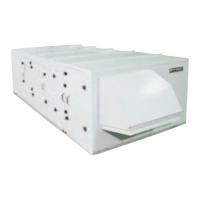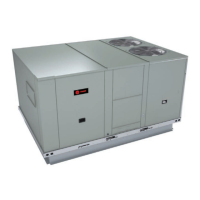64 FAXA-SVX01B-EN
Operation
sequence of
operation
Figure O-SO-2. Dry-bulb control in a neutral DB/dry DP
application
Air to Air Energy Recovery
Energy recovery can significantly
reduce HVAC system first-cost and
operating energy costs. You can use
recovered energy for two purposes:
1. to temper or reheat supply air for
independent control of sensible and
latent capacity, or
2. to precondition outdoor air as it
enters the building for ventilation.
The Packaged FAU offers refrigerant
heat recovery for reheating the supply
air. To precondition the outdoor air, use
the total energy wheel option to
recover energy from building exhaust.
Controlling an Energy Recovery
Ventilator
One way to control an energy recovery
device is to turn it on and off with the
FAU system exhaust fan. In this case,
the total energy wheel enables when
the unit is in occupied mode and the
exhaust fan is running. While this
control method is certainly simple and
effective in some applications, it may
not provide the expected energy
saving benefit, particularly when cold
air (vs. neutral air) is supplied to the
building.
Another more effective approach is to
use the outdoor air dry-bulb to deter-
mine when to energize or de-energize
the energy recovery device. See Figure
AC-7 for an example of this simplified
version of energy recovery. In addition
to being more effective from a control
standpoint, it’s also a very simple
control method because the total
energy wheel (only) enables when all of
the following are true:
• unit is in occupied mode
• exhaust fan is enabled
• outside air temperature is above the
upper limit setpoint (default setpoint
80°F) or below the lower limit setpoint
(default setpoint 45°F)
• outside air temperature is above the
frost protection setpoint (default
setpoint 12°F).
Set the upper limit setpoint to the
anticipated return air dry-bulb tempera-
ture. Set the lower limit setpoint to 10°F
less than the supply air dry-bulb
setpoint. This control strategy prevents
Figure O-SO-1. Dry-bulb control in a cold DB/dry DP
application
the energy recovery device from
potentially adding to the load seen by
the cooling and/or heating system of
the unit, but rather utilizing the device
only at those times when it provides
true operating energy savings.
If using the FAU to deliver cold, dry
conditioned air to the building (outdoor
air is cooled to a low dew point but not
reheated), use the dry-bulb control
option.
Cross Leakage
All energy wheels have some cross
leakage. Therefore, do not use energy
wheels in applications involving toxic or
hazaradous air streams. The
percentage of cross leakage depends
on the pressure differentials across the
wheel section. With Trane Packaged
FAU energy wheels, the exhaust air
transfer ratios are typically low (<4%).

